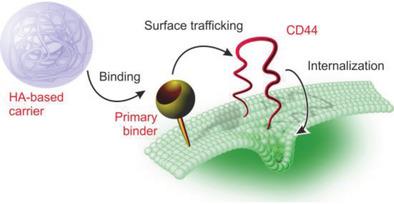当前位置:
X-MOL 学术
›
Adv. Healthcare Mater.
›
论文详情
Our official English website, www.x-mol.net, welcomes your
feedback! (Note: you will need to create a separate account there.)
Binding and Internalization in Receptor-Targeted Carriers: The Complex Role of CD44 in the Uptake of Hyaluronic Acid-Based Nanoparticles (siRNA Delivery).
Advanced Healthcare Materials ( IF 10.0 ) Pub Date : 2019-11-18 , DOI: 10.1002/adhm.201901182 Julio M Rios de la Rosa 1 , Ponpawee Pingrajai 2 , Maria Pelliccia 2 , Alice Spadea 1, 2 , Enrique Lallana 1, 2 , Arianna Gennari 3 , Ian J Stratford 2 , Walter Rocchia 4 , Annalisa Tirella 1, 2 , Nicola Tirelli 2, 3
Advanced Healthcare Materials ( IF 10.0 ) Pub Date : 2019-11-18 , DOI: 10.1002/adhm.201901182 Julio M Rios de la Rosa 1 , Ponpawee Pingrajai 2 , Maria Pelliccia 2 , Alice Spadea 1, 2 , Enrique Lallana 1, 2 , Arianna Gennari 3 , Ian J Stratford 2 , Walter Rocchia 4 , Annalisa Tirella 1, 2 , Nicola Tirelli 2, 3
Affiliation

|
CD44 is an endocytic hyaluronic acid (HA) receptor, and is overexpressed in many carcinomas. This has encouraged the use of HA to design CD44-targeting carriers. This paper is about dissecting the mechanistic role of CD44. Here, HA-decorated nanoparticles are used to deliver siRNA to both tumoral (AsPC-1, PANC-1, HT-29, HCT-116) and non-tumoral (fibroblasts, differently polarized THP-1 macrophages, HUVEC) human cell lines, evaluating the initial binding of the nanoparticles, their internalization rate, and the silencing efficiency (cyclophilin B (PPIB) gene). Tumoral cells internalize faster and experience higher silencing than non-tumoral cells. This is promising as it suggests that, in a tumor, HA nanocarriers may have limited off-target effects. More far-reaching is the inter-relation between the four parameters of the study: CD44 expression, HA binding on cell surfaces, internalization rate, and silencing efficiency. No correlation is found between binding (an early event) and any of the other parameters, whereas silencing correlates both with speed of the internalization process and CD44 expression. This study confirms on one hand that HA-based carriers can perform a targeted action, but on the other it suggests that this may not be due to a selective binding event, but rather to a later recognition leading to selective internalization.
中文翻译:

受体靶向载体中的结合和内化:CD44 在透明质酸纳米颗粒摄取(siRNA 递送)中的复杂作用。
CD44 是一种内吞型透明质酸 (HA) 受体,在许多癌症中过度表达。这鼓励使用 HA 来设计 CD44 靶向载体。本文旨在剖析 CD44 的机制作用。此处,HA 修饰的纳米颗粒用于将 siRNA 递送至肿瘤(AsPC-1、PANC-1、HT-29、HCT-116)和非肿瘤(成纤维细胞、不同极化的 THP-1 巨噬细胞、HUVEC)人类细胞系,评估纳米粒子的初始结合、其内化率和沉默效率(亲环蛋白 B (PPIB) 基因)。与非肿瘤细胞相比,肿瘤细胞内化速度更快,沉默程度更高。这是有希望的,因为它表明,在肿瘤中,HA 纳米载体可能具有有限的脱靶效应。更深远的是该研究的四个参数之间的相互关系:CD44表达、HA在细胞表面的结合、内化率和沉默效率。结合(早期事件)和任何其他参数之间没有发现相关性,而沉默则与内化过程的速度和 CD44 表达相关。这项研究一方面证实了基于HA的载体可以执行靶向作用,但另一方面表明这可能不是由于选择性结合事件,而是由于后来的识别导致选择性内化。
更新日期:2019-12-19
中文翻译:

受体靶向载体中的结合和内化:CD44 在透明质酸纳米颗粒摄取(siRNA 递送)中的复杂作用。
CD44 是一种内吞型透明质酸 (HA) 受体,在许多癌症中过度表达。这鼓励使用 HA 来设计 CD44 靶向载体。本文旨在剖析 CD44 的机制作用。此处,HA 修饰的纳米颗粒用于将 siRNA 递送至肿瘤(AsPC-1、PANC-1、HT-29、HCT-116)和非肿瘤(成纤维细胞、不同极化的 THP-1 巨噬细胞、HUVEC)人类细胞系,评估纳米粒子的初始结合、其内化率和沉默效率(亲环蛋白 B (PPIB) 基因)。与非肿瘤细胞相比,肿瘤细胞内化速度更快,沉默程度更高。这是有希望的,因为它表明,在肿瘤中,HA 纳米载体可能具有有限的脱靶效应。更深远的是该研究的四个参数之间的相互关系:CD44表达、HA在细胞表面的结合、内化率和沉默效率。结合(早期事件)和任何其他参数之间没有发现相关性,而沉默则与内化过程的速度和 CD44 表达相关。这项研究一方面证实了基于HA的载体可以执行靶向作用,但另一方面表明这可能不是由于选择性结合事件,而是由于后来的识别导致选择性内化。































 京公网安备 11010802027423号
京公网安备 11010802027423号